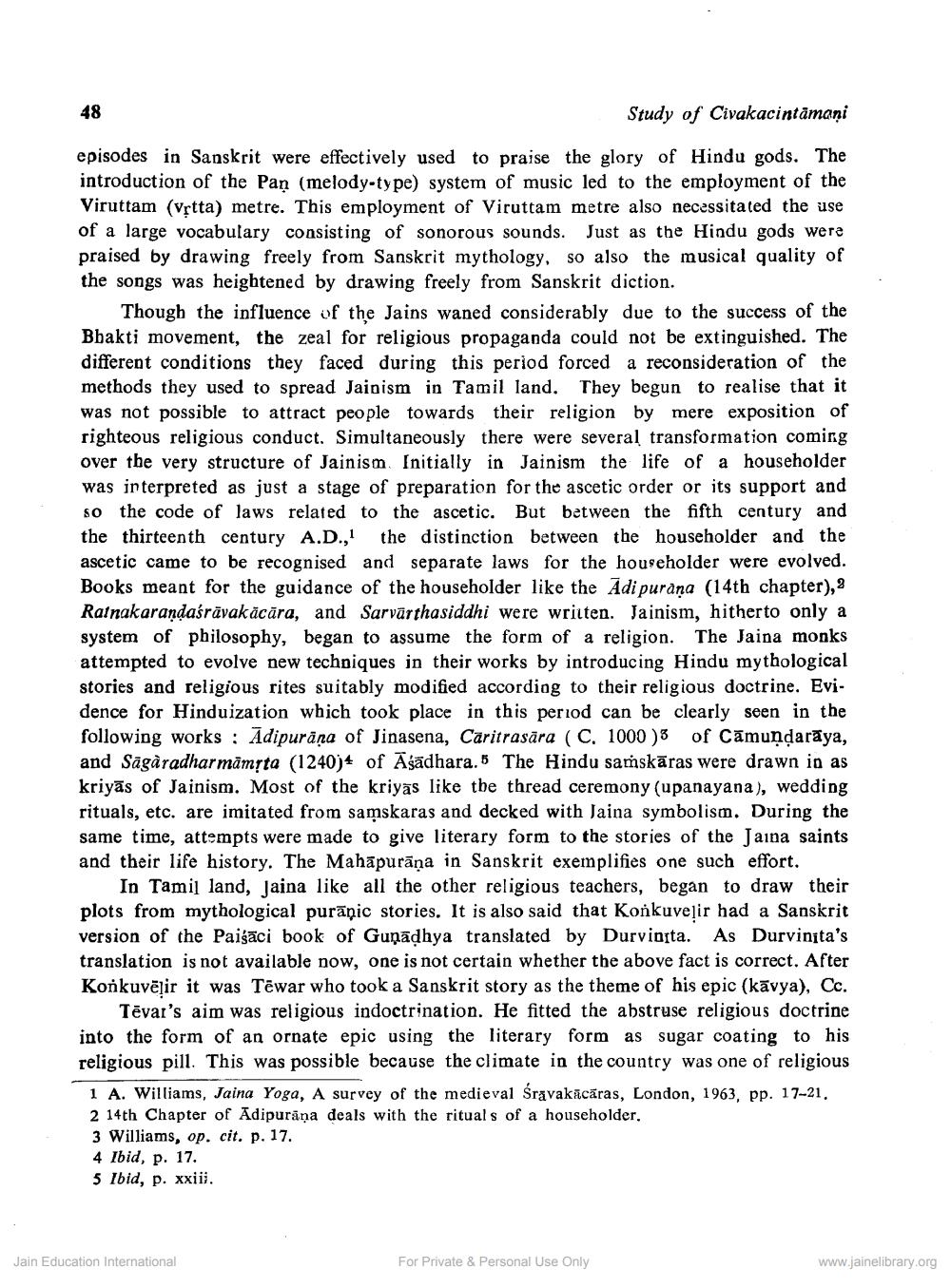________________
48
Study of Civakacintamani
episodes in Sanskrit were effectively used to praise the glory of Hindu gods. The introduction of the Pan (melody-type) system of music led to the employment of the Viruttam (vetta) metre. This employment of Viruttam metre also necessitated the use of a large vocabulary consisting of sonorous sounds. Just as the Hindu gods were praised by drawing freely from Sanskrit mythology, so also the musical quality of the songs was heightened by drawing freely from Sanskrit diction.
Though the influence of the Jains waned considerably due to the success of the Bbakti movement, the zeal for religious propaganda could not be extinguished. The different conditions they faced during this period forced a reconsideration of the methods they used to spread Jainism in Tamil land. They begun to realise that it was not possible to attract people towards their religion by mere exposition of righteous religious conduct. Simultaneously there were several transformation coming over the very structure of Jainism. Initially in Jainism the life of a householder was interpreted as just a stage of preparation for the ascetic order or its support and so the code of laws related to the ascetic. But between the fifth century and the thirteenth century A.D., the distinction between the householder and the ascetic came to be recognised and separate laws for the householder were evolved. Books meant for the guidance of the householder like the Adi purana (14th chapter), 2 Rainakarandabrāvakācāra, and Sarvärthasiddhi were written. Jainism, hitherto only a system of philosophy, began to assume the form of a religion. The Jaina monks attempted to evolve new techniques in their works by introducing Hindu mythological stories and religious rites suitably modified according to their religious doctrine. Evidence for Hinduization which took place in this period can be clearly seen in the following works : Adipurāņa of Jinasena, Caritrasāra (C. 1000 ) 3 of Cāmundarāya, and Sāgàradhar māmộta (1240)+ of Āsādhara. 5 The Hindu samskāras were drawn in as kriyās of Jainism. Most of the kriyās like the thread ceremony (upanayana), wedding rituals, etc. are imitated from saņskaras and decked with Jaina symbolism. During the same time, attempts were made to give literary form to the stories of the Jaina saints and their life history. The Mahāpurāņa in Sanskrit exemplifies one such effort.
In Tamil land, Jaina like all the other religious teachers, began to draw their plots from mythological purānic stories. It is also said that Konkuvelir had a Sanskrit version of the Paisāci book of Guņādhya translated by Durviota. As Durvinita's translation is not available now, one is not certain whether the above fact is correct. After Konkuvē ir it was Tēwar who took a Sanskrit story as the theme of his epic (kāvya), Cc.
Tēvar's aim was religious indoctrination. He fitted the abstruse religious doctrine into the form of an ornate epic using the literary form as sugar coating to his religious pill. This was possible because the climate in the country was one of religious 1 A. Williams, Jaina Yoga, A survey of the medieval Sravakācāras, London, 1963, pp. 17-21, 2 14th Chapter of Adipurāna deals with the rituals of a householder, 3 Williams, op. cit. p. 17. 4 Ibid, p. 17. 5 Ibid, p. xxiii.
Jain Education International
For Private & Personal Use Only
www.jainelibrary.org




